Jump to:
What is Spicy Tuna Kimbap?
Spicy Tuna Kimbap (aka 'Spicy Tuna Gimbap' or 'Chamchi Kimbap' in Korean) is a tasty seaweed rice roll stuffed with fresh perilla leaves and a creamy spicy tuna mayo mixture.
This is a popular Korean food sold at many Korean convenience stores and enjoyed at room temperature. It's a favorite for many commuters or students as it's affordable, delicious and filling!
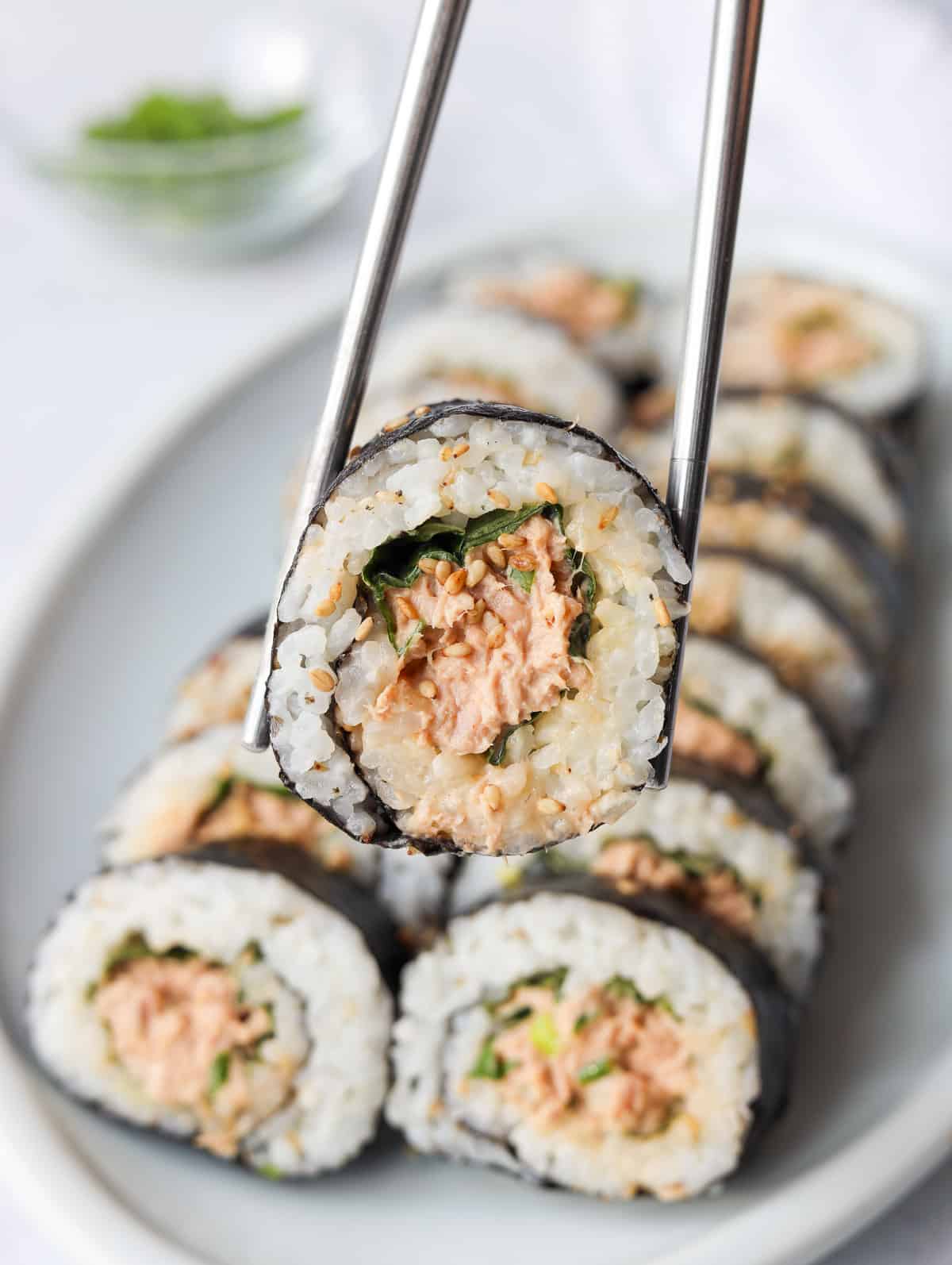
This is my favorite Korean food ever because the creamy tuna filling, fragrant perilla leaves wrapped in rice and roasted seaweed truly hits the spot!
Whenever, I'm not sure what to eat, this quick spicy tuna kimbap recipe is it since it's made with simple ingredients! It's also a great way to get some seafood into your diet.
Also, it takes little time because the canned tuna is already cooked. If you have leftover rice sitting in the fridge, you can simply reheat it and use it for this recipe!
Ingredients & Substitutes
Please scroll down to below recipe card for exact measurements.
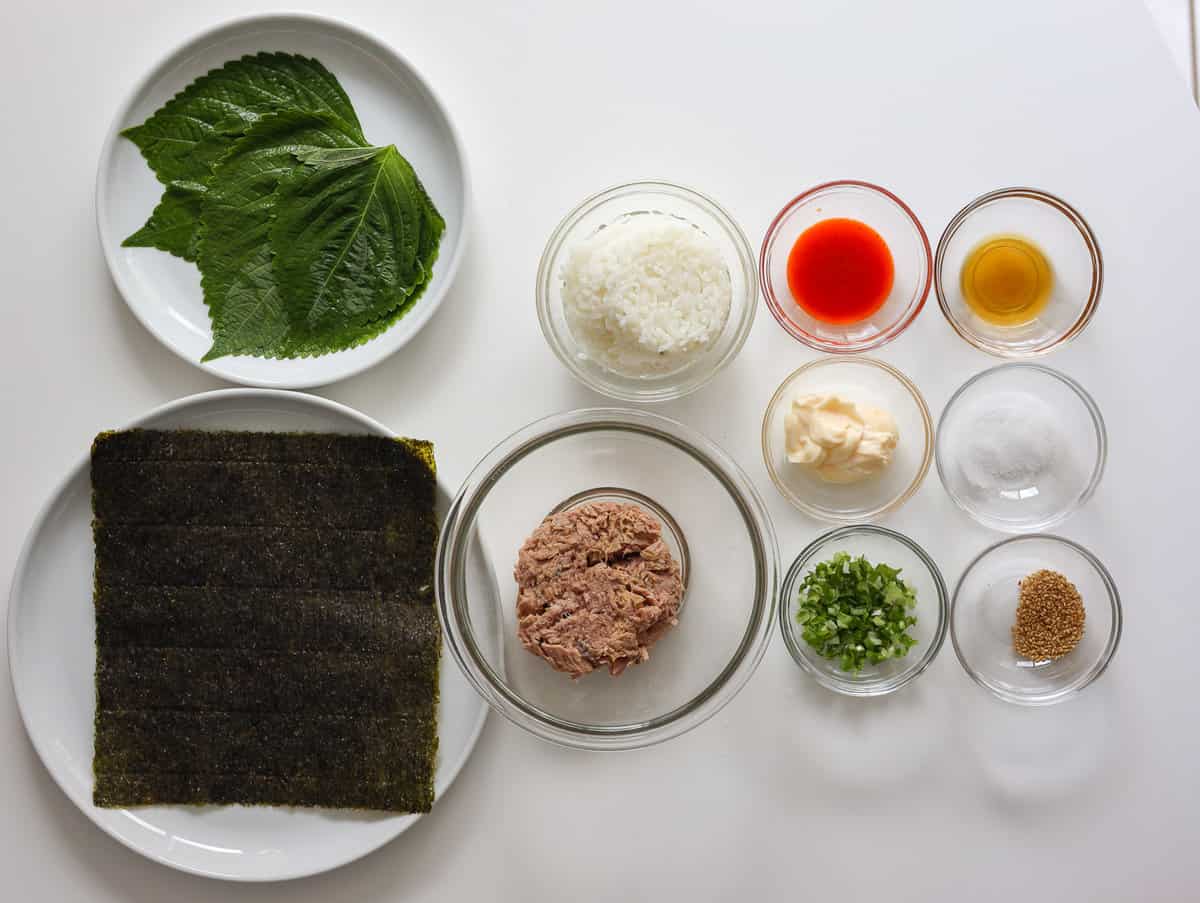
Note: Most Asian grocers will carry these ingredients. You may find some at your select grocery store or online, like on Amazon.
- Gim or Nori: this is a dry roasted seaweed sheet. Most Asian or Korean grocers will sell this and you may find this at select Western grocers in the international aisle. They come in plastic packages, and I recommend buying the one with a resealable zip so it can be stored easily.
- Perilla leaves: these have a wonderful fragrant sesame-mint like smell. Korean grocery stores, like H-mart or select Asian grocers will sell this in the fresh produce aisle with stems removed or left on. Or substitute with a green leaf lettuce like Boston leaf lettuce, romaine lettuce or any soft green lettuce you can find.
- Sesame oil: for that nutty flavor. If you're allergic, omit completely.
- Sesame seeds: to garnish our kimbap. If you're allergic, omit completely.
Seasoned rice
- Cooked Short-grain Rice (aka Sushi rice or Calrose rice): I strongly recommend this type of rice for any rice rolls so the rice sticks together. I don't recommend using medium to long grain rice or it'll fall apart easily because it's not sticky enough. Do not use glutinous rice for this recipe.
- Sesame oil: to season the rice but if you're allergic, omit completely.
- Sesame seeds: to add flavor to the rice but if you're allergic, omit completely.
- Salt
Tuna mayo filling
- Canned tuna: I recommend using canned tuna in oil for best flavor and texture. Or substitute with canned tuna in water and add more mayo to make it creamier.
- Green onion: to balance out the fishy taste in the tuna.
- Kewpie mayo (aka Japanese mayo): this is creamier and thicker than regular mayo. Any Asian grocer, Korean grocer or select online retailers will sell it in a clear plastic bottle with a red cap but there are other brands that sell it in different packaging. Or substitute with regular mayonnaise or American mayonnaise.
- Sriracha sauce: the key ingredient to giving our spicy tuna filling some heat! If you don't have this ingredient, substitute with gochujang which is a Korean red chili paste sold at most Korean grocery stores.
Expert Tips
- If you have leftover nori or gim, freeze it in a freezer-friendly bag and it'll preserve the flavor of the roasted seaweed and keep it drier for longer versus storing it at room temperature.
- Ensure the spicy tuna mayo filling has been combined well for even ingredient distribution. Using a fork is helpful!
- Don't skip the green onions unless you're allergic. They offer incredible flavor and balance the flavors.
- Use freshly cooked rice for best taste and season while it's hot so the seasoning can absorb into the rice. A rice paddle is helpful here.
- Keep the hot rice warm by covering it so it doesn't lose moisture so it can remain sticky.
- Use a bamboo sushi mat to help you roll the kimbap.
- Evenly spread out the rice with clean hands or gloves hands or even a wet rice paddle. This is important for an evenly shaped kimbap roll.
- Don't overstuff the kimbap with tuna filling and only use half the mixture otherwise it will spill out of the roll.
- Don't evenly spread out the tuna mayo filling when initially adding it to the center of the perilla leaves. The pressure from the rolling action will spread it out evenly. Otherwise, the filling will spill out from the sides.
- Oil the sharp knife when slicing the kimbap! This is key to slicing the roll easily.
Instructions
Below are step-by-step instructions on how to make spicy tuna kimbap:

- Strain the canned tuna with a fine sieve and a fork to force the liquids out. Discard the liquids. Then in a medium bowl, combine strained tuna, green onions, Japanese mayo and sriracha sauce with a fork to make your spicy tuna filling. Set aside.
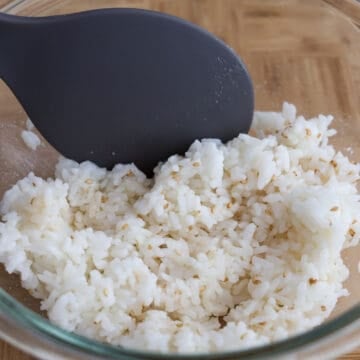
- In a large bowl with hot cooked rice, season with sesame oil, sesame seeds, and a bit of salt. Mix well. Cover with a damp towel or lid and keep warm at room temperature.
Assembling the Kimbap
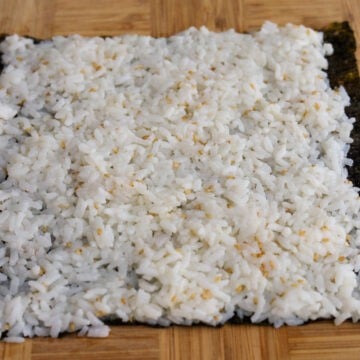
- Vertically place a sheet of gim or nori rough side up and shiny side down on a cutting board (or on a bamboo sushi mat if you have one). Place 1 cup or a half portion the seasoned rice into the center of the gim or nori. Using clean hands or a rice paddle, evenly spread the portion of rice out and create a 1-inch border at the end furthest away from you.
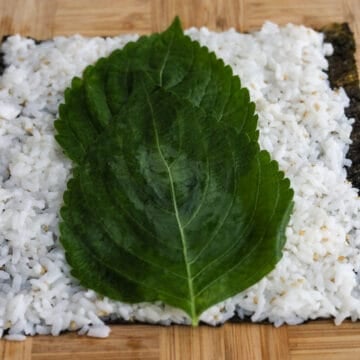
- Place two perilla leaves in the center of the rice, overlapping them so they can fit within the sheet of seaweed.
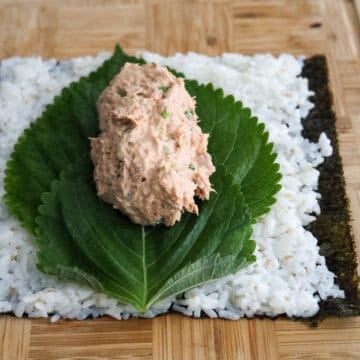
- Scoop half of the spicy tuna mixture on top of the perilla leaves and evenly shape the tuna mixture into a thick log. Do not spread it out thinly or when you roll it, the tuna filling will spill out from the sides. The tuna filling will eventually spread out evenly with enough rolling pressure.
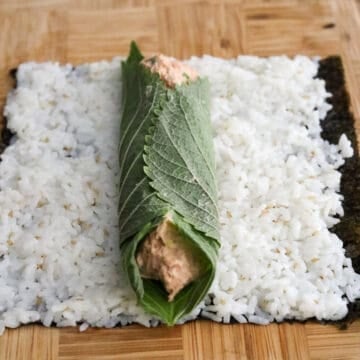
- Fold the perilla leaves over the tuna mixture, to hold the tuna mixture in.
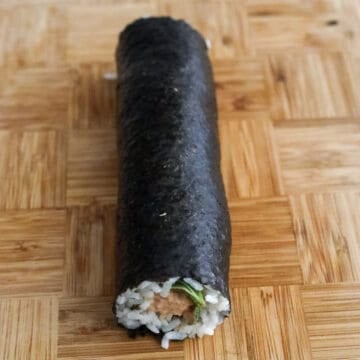
- Begin rolling the kimbap by starting at the end closest to you. Firmly roll and tuck the ingredients and be careful not to squeeze the tuna filling out as you roll. Once you reach the end, let the roll sit on top where the border was so it can stick to the rest of the roll with the residual heat from the rice.
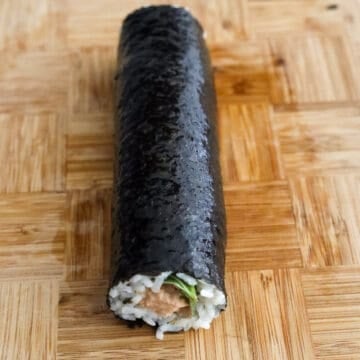
- Then evenly pour ½ teaspoon sesame oil on the kimbap roll and with clean hands or a brush, spread it all over the seaweed. Repeat the above steps for the remaining roll.
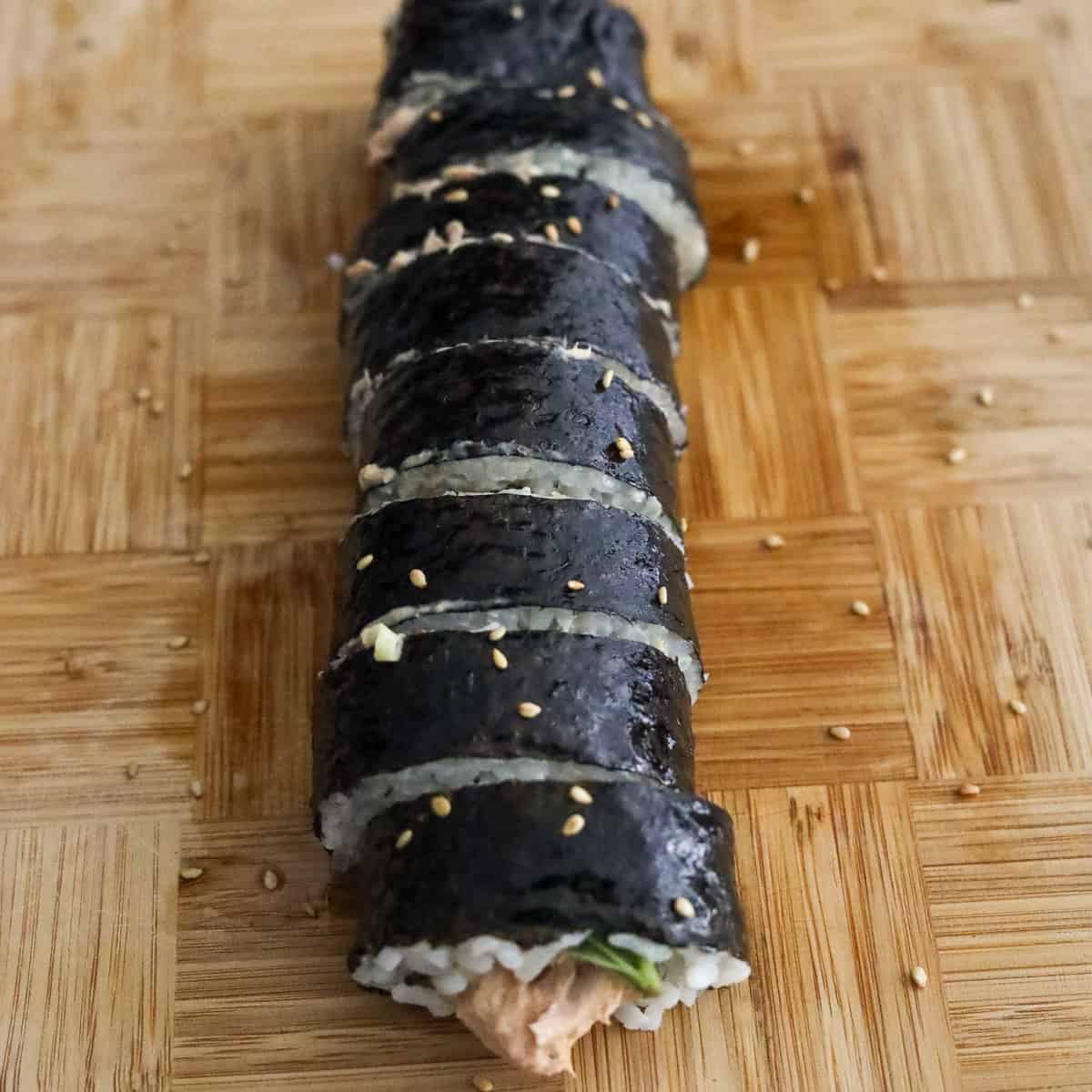
- Next carefully brush or rub some sesame oil onto the sides of a sharp knife. Firmly hold the kimbap roll with your dominant hand (but don't squeeze) and slice it with the knife into 1-inch-thick pieces. Then garnish with sesame seeds. Enjoy!
Storage
- Spicy tuna kimbap is best enjoyed immediately or within 12 hours.
- Leftovers can be stored in an airtight container in the fridge for up to 2 days but as a warning, leftovers don't taste as great as the cold air in the fridge hardens the rice. To reheat: microwave the kimbap covered with a damp paper towel for 30-60 seconds until warm. Alternatively, you can dip the kimbap pieces in beaten egg and fry them in a pan on medium heat on both sides until the egg is cooked and the roll is warm throughout.
- Freezer-friendly? I don't recommend freezing spicy tuna kimbap because the rice hardens even after reheating.
Pairing Suggestions
Spicy tuna kimbap serves well with other variations of kimbap or with Korean side dishes:
FAQ
You can make spicy tuna kimbap up to 2 days in advance by preparing the seasoned rice and tuna mayo mixture and storing the different components into separate airtight containers in the fridge. Then on the day of serving, reheat the seasoned rice in the microwave covered for 2-3 minutes until hot and assemble the rolls as instructed.
I don't recommend assembling and storing the rolls in advance in the fridge to reheat later because this will change the taste and texture of the rolls.
Yes, you may use leftover cooked rice from 1-2 days ago but you'll need to microwave it covered with a damp paper towel or lid for 2-3 minutes until hot. If it’s very old rice, it’s best not to use it or it’ll have a hard time sticking together.
These spicy tuna seaweed rice rolls are best consumed fresh or within 12 hours. Moreover, when cooked rice is sitting at room temperature, it can grow bacteria quickly, so it doesn't last a long time.
It's usually eaten fresh at room temperature while it's still warm. However, if the kimbap is stored in the cold, the rice hardens and it won't be tasty.
Kimbap originates from Korea and is usually made of cooked ingredients. Koreans will usually coat the kimbap with toasted sesame oil and garnish with sesame seeds for additional flavor.
On the other hand, the Japanese use cooked rice and raw fish to make Japanese sushi. Sesame oil is only mixed into the cooked rice and not applied to the sushi roll.
Other recipes you may enjoy
📖 Recipe

Easy 15-min. Spicy Tuna Kimbap
Ingredients
- 2 sheets nori or gim (dry roasted seaweed)
- 4 perilla leaves washed & dried with stems trimmed (or sub with green leaf lettuce)
- ½ teaspoon sesame oil to season kimbap
- ½ teaspoon sesame seeds to garnish kimbap
For the Seasoned rice:
- 2 cups cooked short grain rice hot
- 1 teaspoon sesame oil
- 1 teaspoon sesame seeds
- 1 teaspoon salt
For the Spicy Tuna Filling:
- 5.3 oz canned tuna in oil or canned tuna in water
- 2 tablespoon green onion very finely chopped
- 2 tablespoon Japanese mayo aka Kewpie mayo (or regular mayo)
- 1-2 tablespoon sriracha depending on your spice tolerance (or sub with gochujang)
Instructions
- Strain the canned tuna with a fine sieve and a fork to force out the liquids. Discard the liquids.
- In a medium bowl, combine strained tuna, green onions, Japanese mayo and sriracha sauce with a fork to make your spicy tuna filling. Taste test the filling and add more sriracha if you prefer it more spicy. Set aside.
- In a large bowl with hot cooked rice, season with sesame oil, sesame seeds, and salt. Mix well. Cover with a damp towel or lid and keep warm at room temperature.
- Vertically place a sheet of gim or nori rough side up and shiny side down on a cutting board (or on a bamboo sushi mat if you have one). Place 1 cup or a half portion the seasoned rice into the center of the gim or nori. Using clean hands or a rice paddle, evenly spread the portion of rice out and create a 1-inch border at the end furthest away from you.
- Place two perilla leaves in the center of the rice, overlapping them so they can fit within the sheet of seaweed.
- Scoop half of the spicy tuna mixture on top of the perilla leaves and evenly shape the tuna mixture into a thick log (see blog post for visuals). Do not spread it out thinly or when you roll it, the tuna filling will spill out from the sides. The tuna filling will eventually spread out evenly with enough rolling pressure.
- Fold the perilla leaves over the tuna mixture, to hold the tuna mixture in.
- Begin rolling the kimbap by starting at the end closest to you. Firmly roll and tuck the ingredients and be careful not to squeeze the tuna filling out as you roll. Once you reach the end, let the roll sit on top where the border was so it can stick to the rest of the roll with the residual heat from the rice.
- Then evenly pour ½ teaspoon sesame oil on the kimbap roll and with clean hands or a brush, spread it all over the seaweed. Repeat the above steps for the remaining roll.
- Next carefully brush or rub some sesame oil onto the sides of a sharp knife. Firmly hold the kimbap roll with your dominant hand (but don't squeeze) and slice it with the knife into 1-inch-thick pieces. Then garnish with sesame seeds. Enjoy!


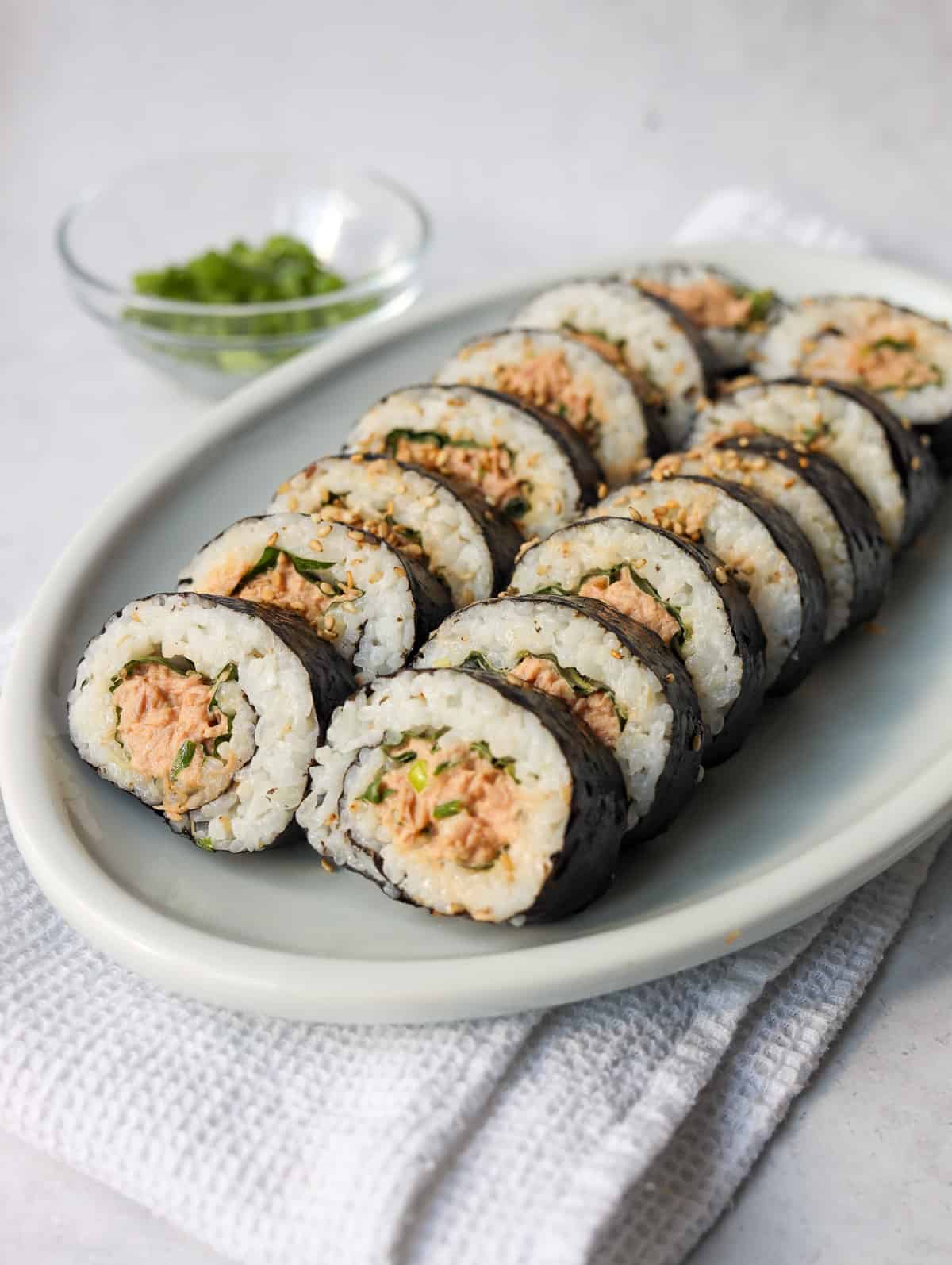

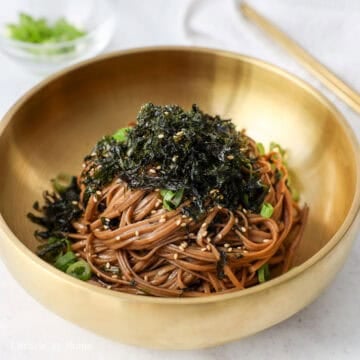

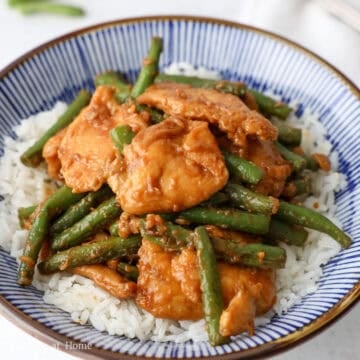
claire
soooo good just inhaled the one i made
Christie Lai
Ahahaha! I loved reading this, Claire! Happy to hear this and thanks for making my recipe.
Nat V C
This was so flavorful, delicious,
and so much fun to make!
I am very new to Korean cooking, and this was nice and simple! Thanks so much! I will definitely be making this again!
christieathome
Thanks so much for making my recipe and for leaving a kind review, Nat! So glad you liked it and welcome to Korean cooking! I hope you continue to enjoy this wonderful and flavourful cuisine 🙂
Stephanie
Wow!!! This recipe is soooooo delicious and super easy to whip up! Definitely going to be a regular snack in our house. Thank you for sharing. 🙂
Mary SM
This looks sooooo good!
I’m going to fix it tomorrow.
christieathome
Thanks so much! I hope you enjoy it!
Heidi | The Frugal Girls
I know I need to try this recipe! Your totally tasty looking Tuna Kimbap look absolutely fabulous, and I bet the sriracha gives it such a fun boost of flavor!
Michelle | Sift & Simmer
I love kimbap but don't have it as nearly as much as I should! This tuna kimbap looks delicious and healthy. It would be a good way to get my kids to eat more veggies since they already love sushi-style food!